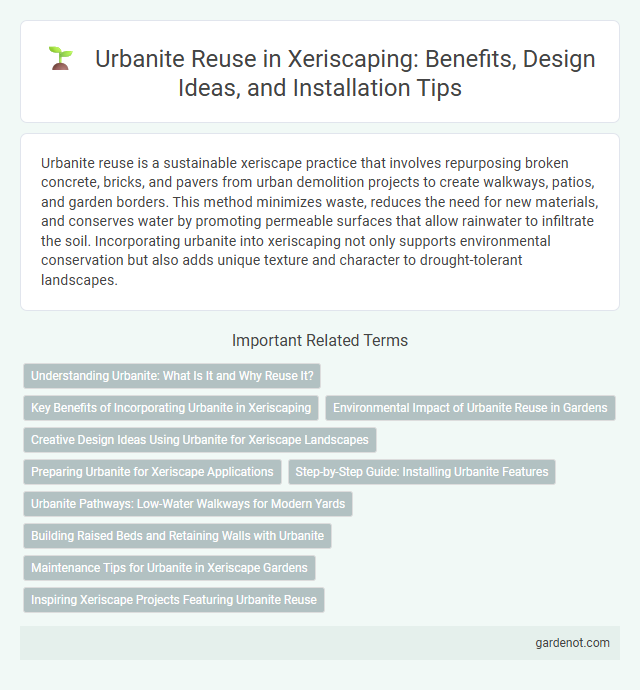Urbanite reuse is a sustainable xeriscape practice that involves repurposing broken concrete, bricks, and pavers from urban demolition projects to create walkways, patios, and garden borders. This method minimizes waste, reduces the need for new materials, and conserves water by promoting permeable surfaces that allow rainwater to infiltrate the soil. Incorporating urbanite into xeriscaping not only supports environmental conservation but also adds unique texture and character to drought-tolerant landscapes.
Understanding Urbanite: What Is It and Why Reuse It?
Urbanite consists of broken concrete pieces repurposed from demolished sidewalks, driveways, and patios, serving as a sustainable alternative to new construction materials. Reusing urbanite in xeriscaping promotes environmental conservation by reducing landfill waste and the demand for virgin resources. Its porous texture enhances soil drainage, aiding water-efficient landscapes designed to thrive with minimal irrigation.
Key Benefits of Incorporating Urbanite in Xeriscaping
Urbanite reuse in xeriscaping conserves water by promoting efficient drainage and reducing irrigation needs through permeable surfaces. Incorporating Urbanite enhances soil stability and prevents erosion, supporting sustainable landscape health in arid regions. This eco-friendly material also minimizes waste by repurposing concrete debris, contributing to environmental conservation and cost savings.
Environmental Impact of Urbanite Reuse in Gardens
Reusing urbanite in xeriscape gardens significantly reduces construction waste sent to landfills, lowering the environmental footprint associated with new material extraction and processing. The porous nature of urbanite enhances soil aeration and water retention, promoting healthier plant growth and reducing irrigation needs. Incorporating urbanite supports sustainable landscaping by conserving natural resources and minimizing urban runoff pollution.
Creative Design Ideas Using Urbanite for Xeriscape Landscapes
Urbanite, recycled broken concrete, offers a sustainable, cost-effective material for xeriscape landscapes by reducing waste and water use. Creative design ideas include using urbanite as irregular stepping stones, retaining walls, or decorative border accents to add texture while conserving moisture in arid gardens. Integrating urbanite with drought-tolerant plants enhances water efficiency and aesthetic appeal, making it an ideal component of environmentally friendly xeriscaping.
Preparing Urbanite for Xeriscape Applications
Preparing urbanite for xeriscape applications involves thorough cleaning and breaking down large pieces to create permeable, lightweight aggregates that improve soil drainage and reduce water retention. Properly sorted urbanite enhances the soil structure, allowing native drought-resistant plants to thrive by promoting efficient water use and minimizing irrigation needs. Integrating crushed urbanite into xeriscape designs optimizes sustainability by recycling construction debris and reducing the demand for traditional landscaping materials.
Step-by-Step Guide: Installing Urbanite Features
Begin installing urbanite features by collecting broken concrete pieces or reclaimed paving stones suitable for creating durable landscaping elements. Clean and sort the urbanite to fit the desired design, ensuring stable placement for pathways, retaining walls, or garden beds. Secure the urbanite using compacted base layers and mortar or soil to maintain structural integrity and enhance drought-resistant xeriscape aesthetics.
Urbanite Pathways: Low-Water Walkways for Modern Yards
Urbanite pathways provide an eco-friendly solution for modern yards by reusing broken concrete slabs to create durable, low-water walkways that reduce water consumption and promote sustainable landscaping. These porous pathways allow rainwater to infiltrate the soil, minimizing runoff and supporting xeriscape principles. Incorporating Urbanite in xeriscape designs enhances urban sustainability by conserving resources and reducing waste in residential outdoor spaces.
Building Raised Beds and Retaining Walls with Urbanite
Urbanite, consisting of broken concrete pieces, offers an eco-friendly solution for building raised beds and retaining walls in xeriscape gardening. Its porous structure enhances drainage, crucial for water-efficient plant growth in arid landscapes. Utilizing Urbanite reduces construction waste while providing durable, cost-effective, and aesthetically appealing hardscaping elements.
Maintenance Tips for Urbanite in Xeriscape Gardens
Urbanite reuse in xeriscape gardens offers durable, eco-friendly hardscape options that reduce water consumption and soil erosion. To maintain urbanite effectively, regularly remove debris and moss to prevent surface damage and slipping hazards while ensuring proper drainage to avoid water pooling. Seal the urbanite surfaces every few years with a breathable, water-resistant sealant to enhance longevity and protect against weathering in xeriscape environments.
Inspiring Xeriscape Projects Featuring Urbanite Reuse
Urbanite reuse transforms broken concrete and brick into durable, eco-friendly materials for xeriscape projects, significantly reducing waste and conserving natural resources. Innovative designs incorporate urbanite to create permeable walkways, raised garden beds, and decorative retaining walls that enhance water efficiency and aesthetic appeal. These inspiring xeriscape projects demonstrate how sustainable urban waste reuse supports drought-tolerant landscaping and water conservation efforts.
Urbanite reuse Infographic

 gardenot.com
gardenot.com